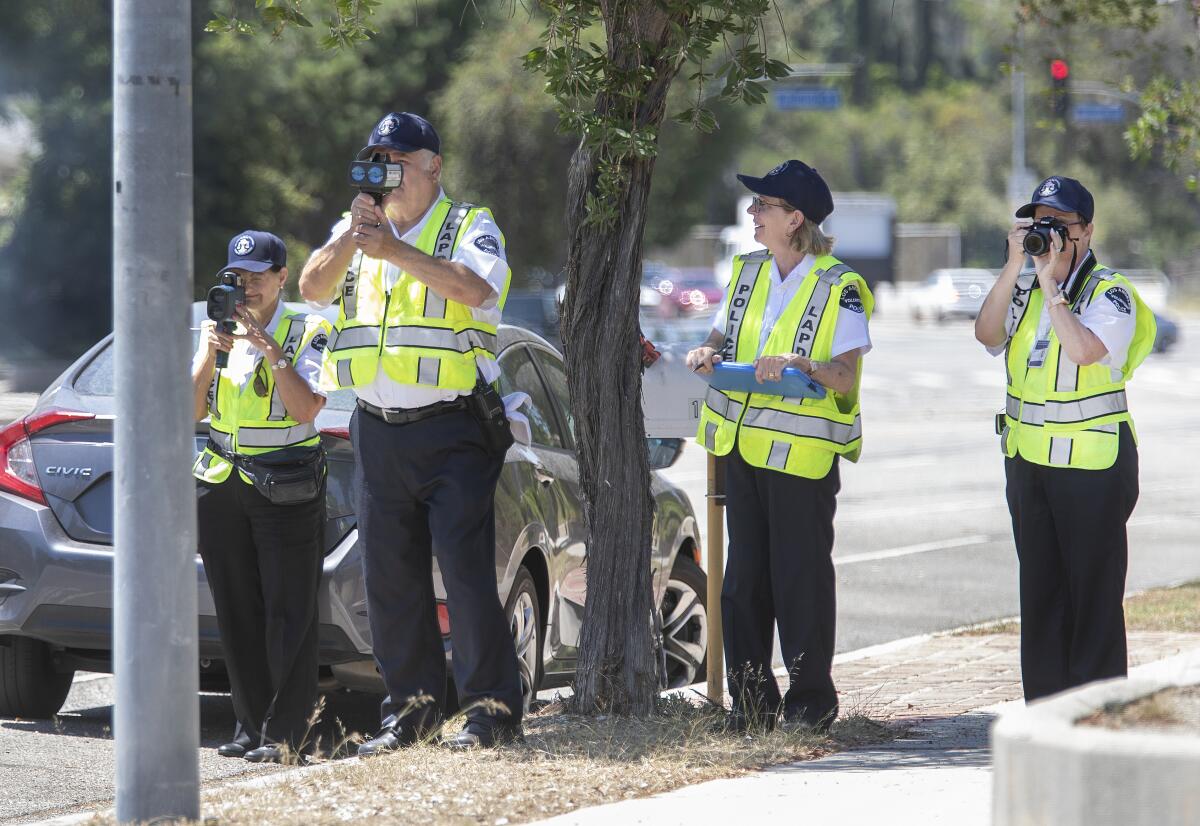Want to patrol your neighborhood and go on stakeouts? The LAPD needs 5,000 volunteers

- Share via
As a silver Toyota Prius barreled down Balboa Boulevard in the San Fernando Valley, Karla Hanley aimed a radar gun at the car.
“It’s 54 on this one,” yelled Hanley, who was wearing a reflective vest emblazoned with the word “Police.”
Terri Perez then focused a camera on the car, snapping a photo of the license plate. The Los Angeles Police Department will soon send the driver a warning letter about going 14 mph over the speed limit.
But Hanley and Perez aren’t cops. The women are part of a volunteer force the LAPD created in 2016 to patrol neighborhoods and deter property crimes.
After starting in the Devonshire Division, the program has grown to more than 400 volunteers across the city. But now, Chief Michel Moore wants to recruit 5,000 individuals to serve at least eight hours a month. The duties have expanded from basic patrols to undercover surveillance and operating bike and horse units in the San Fernando Valley and walking the beat with officers on Hollywood Boulevard.
“We see this as a benefit,” said Deputy Chief Jorge Rodriguez, commanding officer of the Valley Bureau. “They’re our partners. They get to see what police do. It’s a win-win situation. It is a force multiplier.”
The LAPD launched the volunteer patrols as police were battling rising crime. Putting volunteers on the streets to watch for suspicious activity, officials said, would free up officers to focus on the crime fight.
Police leaders now credit the program for the nearly double-digit reductions in property crimes since 2017 in the Valley Bureau’s seven geographic divisions: Devonshire, Foothill, Mission, North Hollywood, Topanga, Van Nuys and West Valley. For example, property crimes fell 26% in Devonshire and 17% in the West Valley in the past two years, records show.
Deputy Chief Kris Pitcher, now chief of detectives, was an assistant commanding officer in the Valley Bureau in 2016 and helped spread volunteers into other divisions. The volunteers, he said, are effective in deterring residential and commercial burglaries. People notice a two-person team in a BMW i3 — complete with flashing amber lights and a “Volunteer Community Patrol” sign on each door — snaking through neighborhoods, he said.
“They are the eyes and ears of the community,” Pitcher said. “It’s been very successful.”
Volunteers range from college students to people in their eighties. While many are retired, some work full time and volunteer their spare time. From the start, volunteers are warned they cannot take any enforcement action. They do not carry guns. Instead, they use radios or phones to report information directly to officers.
A recruitment brochure says volunteers “don’t race through red-light intersections with lights and sirens” like on television shows.
Not every person can be a volunteer and get access to police stations, vehicles and computers. People with felony convictions and certain misdemeanors are not eligible. The department conducts an extensive background check and requires volunteers to complete eight weeks of training to learn LAPD procedures, driving skills, surveillance techniques and more.
Other duties could include retrieving evidence for detectives, performing vacation checks and taking nuisance reports. When it comes to surveillance, volunteers do not wear a uniform and will watch neighborhoods, shopping centers, malls or any other areas where police need help.
Rodriguez, the deputy chief, said volunteers could face danger but said they are constantly reminded about safety and warned not to take police action. He emphasized that sworn officers are nearby and communicating with volunteers. Still, he said, several volunteers have been dismissed for getting “too close to the action.”
He said he understands critics might say the department uses the program to sidestep the hiring of more officers. But even if the LAPD had 20,000 officers instead of 10,000, it would still use volunteers, he added.
“How many eyes are enough?” Rodriguez said. “How many ears are enough?”
To combat petty thefts and vehicle break-ins in the Hollywood Entertainment District, Capt. Cory Palka began using volunteers this month to shadow officers walking their beat. Thefts by criminals preying on tourists are rising, he said. The program allows community members to get a better understanding of what police do each day, Palka said.
“A lot of them are civic-minded and want to serve the community,” said Palka, who was promoted last week to commander in the West Bureau.
Before hitting the street this week in Devonshire, six volunteers chatted in a briefing room and waited for the watch commandeer to give them instructions. Lt. Pablo Monterrosa thanked the group for donating their time and asked them to patrol near a mall.
“You’re making a difference,” he said. “The community sees you out there.”
Bill Cotter, 65, retired from the entertainment and banking industries and was one of the original Devonshire volunteers. He said he joined the program “to give something back to the community.”
At first, Cotter said he didn’t know whether rank-and-file officers would accept volunteers, but now the civilians are all considered team members.
Cotter said it’s an adrenaline rush for volunteers to spot a potential crime. But then their training takes over and they call officers, he said.
“If we ever feel in danger, we leave,” Cotter said. “We’re not looking for mavericks or a wanna-be [officer],” he said, noting that he did get nervous the first time he radioed the police helicopter during a hunt for a suspect.
Meanwhile, Hanley, Perez and two other volunteers spent 10 minutes washing dirt from the BMWs before hitting the street for four hours.
It didn’t take long to catch the attention of drivers speeding through the intersection of Balboa Boulevard and Orozco Street. Some drivers tapped their brakes; others weren’t fazed.
Hanley, 68, and Nishan Darakdjian, 73, pointed radar guns at cars descending a hill. Perez shot photos of license plates, and Amy Schneider, 63, logged the vehicle information. The Valley Traffic Division will send the warning letters. It took only 20 minutes to fill up a sheet with information on a dozen drivers going 10 mph over the 40 mph limit.
Hanley, who spent 33 years as a Navy nurse, said she joined more than two years ago after neighbors talked about the program on Next Door, a social network for neighborhoods.
“The police get a bad rap,” she said. “I want to support them.”
Perez, who called herself a retired grandmother, said the radar details might change a driver’s behavior once a warning letter comes in the mail. She became a volunteer 18 months ago after thieves burglarized her neighbor’s home in Granada Hills.
“What can I do to help?” Perez recalled asking herself. “This makes me feel good to help the community and police.”
More to Read
Sign up for Essential California
The most important California stories and recommendations in your inbox every morning.
You may occasionally receive promotional content from the Los Angeles Times.











